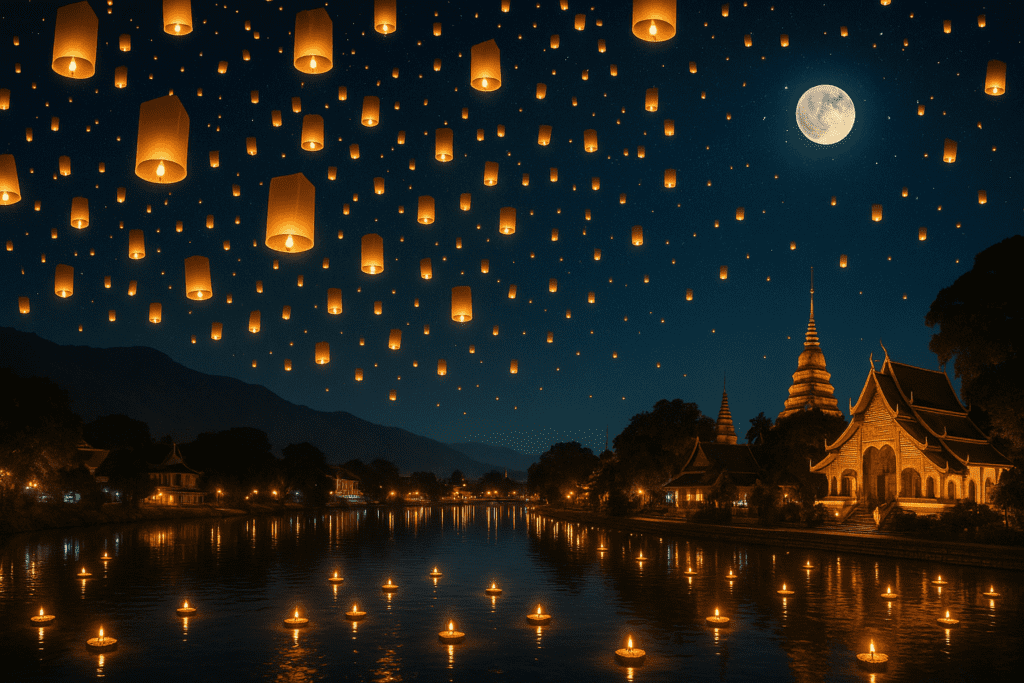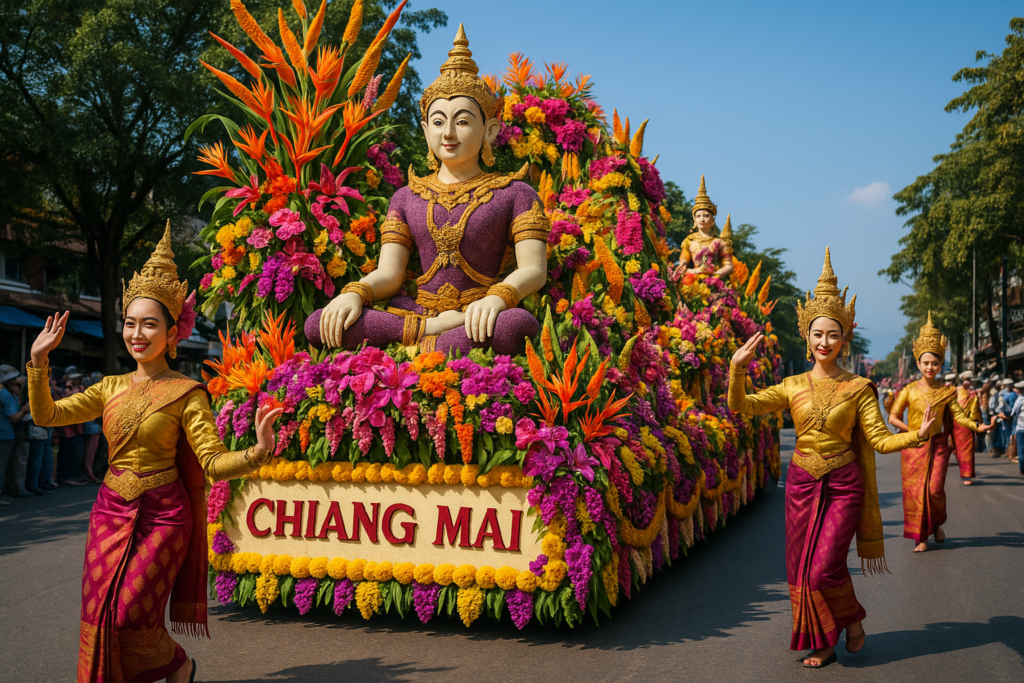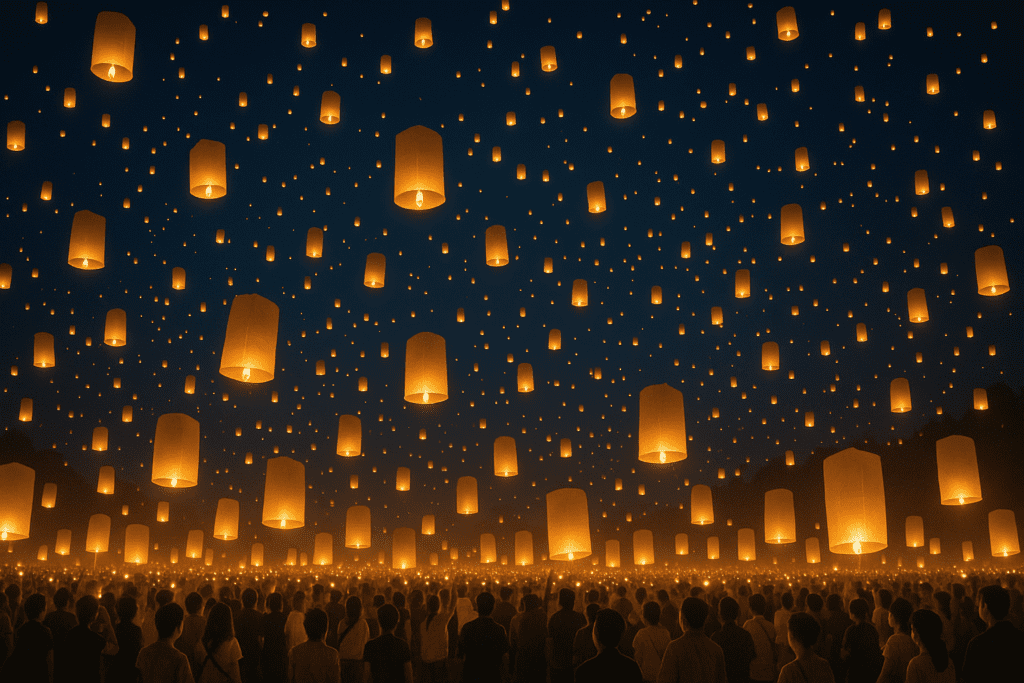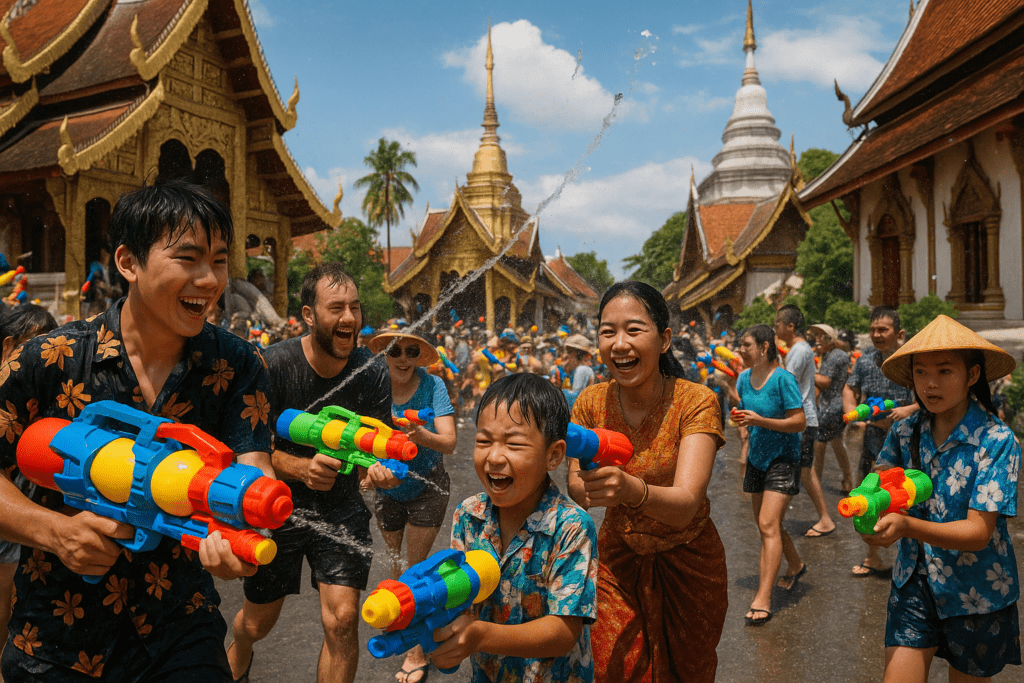Estimated reading time: 12 minutes
Key Takeaways
- Chiang Mai hosts four major festivals throughout the year: Yi Peng/Loy Krathong (November), Songkran (April), Flower Festival (February), and Rocket Festival (May/June)
- The Yi Peng Lantern Festival on November 5, 2025, is the most iconic celebration featuring thousands of glowing lanterns released into the night sky
- Book accommodations and festival tickets 3-6 months in advance as prices triple during festival periods
- Respect cultural etiquette by dressing modestly at temples and participating reverently in religious ceremonies
- Each festival offers unique experiences: spiritual transcendence (Yi Peng), epic water fights (Songkran), artistic beauty (Flower Festival), and agricultural traditions (Rocket Festival)
Table of Contents
- What Makes Chiang Mai Festivals So Special?
- The Yi Peng Lantern Festival: A Sky Full of Hopes and Dreams
- The Magic of Loy Krathong Chiang Mai: When Water and Sky Unite
- Get Soaked in Fun: A Guide to Songkran Chiang Mai
- Chasing Blooms at the Flower Festival Chiang Mai
- Digging Deeper: Other Cultural Events in Chiang Mai
- How to Plan Your Perfect Festival Adventure
- Your Festival Adventure Awaits

Picture this: thousands of glowing paper lanterns drifting into the star-filled night sky like a river of light, while below, countless flickering candles float down the moonlit river. Welcome to Chiang Mai during festival season, where magic isn’t just possible—it’s practically guaranteed.
Chiang Mai is often called the cultural heart of Thailand, bursting into life with a vibrant tapestry of traditional celebrations Chiang Mai. From ancient Buddhist rituals that have been practiced for centuries to dazzling displays of floral artistry, this northern city offers festival experiences unlike anywhere else in Asia. Learn more about Chiang Mai’s cultural significance
This guide will walk you through not just Yi Peng, but the full calendar of Chiang Mai festivals, helping you plan your own immersive experience in one of Southeast Asia’s most culturally rich destinations. For a complete itinerary including festival attendance, check out our Ultimate Chiang Mai 5-Day Travel Guide.
Among these incredible events, the Yi Peng lantern festival shines brightest, enchanting visitors with its celestial beauty and profound spiritual meaning. But here’s the thing—Yi Peng is just one gem in a crown of spectacular celebrations that happen throughout the year.
What Makes Chiang Mai Festivals So Special?

Let me be honest—I’ve been to my fair share of festivals around the world, but nothing quite prepared me for what I experienced in Chiang Mai. These aren’t just parties or tourist attractions. They’re living, breathing pieces of history.
Chiang Mai festivals refer to a series of culturally rich events deeply rooted in the ancient Lanna kingdom’s heritage, Buddhist traditions, and local animist beliefs that have shaped this region for over 700 years. These celebrations act as vital social gatherings that preserve ancient traditions, foster community spirit, and showcase Chiang Mai’s incredible artistic legacy.
What struck me most was how locals don’t just attend these festivals—they live them. Families spend weeks preparing their homes, temples organize community-wide activities, and everyone from grandmothers to toddlers participates in the rituals.
When are festivals in Chiang Mai?
Here’s your quick reference guide to planning around the major celebrations:
• Early February: Flower Festival – Vibrant parades and elaborate garden displays
• Mid-April: Songkran – The nationwide Thai New Year’s epic water festival
• May/June: Bun Bang Fai (Rocket Festival) – Primarily in nearby provinces, featuring homemade rockets
• November: Loy Krathong & Yi Peng – The famous double-header of light, water, and sky
To see detailed advice on the best times to visit and plan around these festivals, read our guide on the Best Time to Visit Chiang Mai.
I’ll be straight with you—these cultural events in Chiang Mai are often the primary reason travelers visit. They offer a unique chance to participate in living history rather than just observing it from the sidelines. There’s something transformative about lighting your own lantern or joining thousands of others in ancient rituals that connect you to centuries of human hope and renewal.
The Yi Peng Lantern Festival: A Sky Full of Hopes and Dreams

Now, let’s talk about the main event. The Yi Peng lantern festival is hands down Chiang Mai’s most iconic celebration, and honestly, it’s not hard to see why. Imagine standing in a field with thousands of other people, each holding a paper lantern glowing from within, and then—at exactly the same moment—everyone releases their light into the darkness.
The silence that follows is almost spiritual.
Origins and Spiritual Meaning
The Yi Peng lantern festival has roots stretching back to the 13th-century Lanna Kingdom. This isn’t just a pretty light show—it’s a profound Buddhist tradition of “making merit.” Releasing a khom loi (sky lantern) symbolizes letting go of misfortunes from the past year and making wishes for good luck and a bright future. Discover the spiritual significance of Yi Peng
It’s also a way to honor ancestors, and in Buddhist belief, the higher your lantern rises, the more merit you accumulate. Watching elderly Thai couples carefully write their wishes on lantern paper before release is enough to bring tears to your eyes.
When and Where to Experience Yi Peng
Here’s what you need to know for planning: Yi Peng is held on the full moon of the 12th month of the Thai lunar calendar, which usually falls in November. In 2025, Yi Peng falls on November 5.
Mark that date now if you’re serious about experiencing this magic.
The celebrations center around the Ping River banks, the Old City moat, and famous temples like Wat Phan Tao and Wat Chedi Luang. If you’re planning temple visits, our guide to Exploring Chiang Mai’s Temples by Motorbike can help you map out the best routes. But honestly, during Yi Peng, the entire city becomes one giant festival ground.
What You’ll Actually See and Do
Mass Lantern Release: This is the moment everyone comes for. Thousands of glowing lanterns released simultaneously create what locals call a “river of fire” in the night sky. The sight is so breathtaking that even the most hardened travelers stand there with their mouths open like kids seeing fireworks for the first time.
Temple Ceremonies: While the lantern releases get all the Instagram attention, the temple ceremonies are where you’ll find the soul of Yi Peng. Monks chant in ancient Pali while locals light candles and small lanterns around centuries-old stupas. The atmosphere is serene and deeply moving.
Parades and Decorations: Throughout the week leading up to the main event, the city buzzes with parades, cultural performances, and traditional Lanna-style lantern decorations hanging from every home and temple.
Practical Tips and Cultural Etiquette
Let’s get down to logistics. You have two main ways to participate:
Option 1: Free public releases along Nawarat Bridge and Ping River. These can be extremely crowded—think Times Square on New Year’s Eve crowded—but they’re authentic and free.
Option 2: Private, ticketed events at venues like CAD Khomloy Sky Lantern or Mae Jo. These offer a more controlled experience, often with food and performances included. Prices range from 1,000–5,000 THB, and you absolutely must book months in advance. I mean it—these sell out faster than concert tickets.
Best viewing spots include Nawarat Bridge, Tha Pae Gate, and riverside restaurants. My advice? Arrive early and claim your spot. Bring snacks and water because you’ll be there for hours.
Cultural respect is non-negotiable. Dress modestly with covered shoulders and knees when entering temple grounds. Act reverently during ceremonies—this means no loud talking or selfie sticks during prayers. Only use designated, biodegradable lanterns, and never release them near the airport (there’s actually a ban for obvious safety reasons).
The Magic of Loy Krathong Chiang Mai: When Water and Sky Unite
Here’s something that makes Chiang Mai extra special—while most of Thailand celebrates either Yi Peng or Loy Krathong, Chiang Mai celebrates both. Simultaneously.
Loy Krathong Chiang Mai is a nationwide festival dedicated to honoring Phra Mae Khongkha, the goddess of water. The symbolism is beautiful: releasing a krathong (a small, decorated raft made of banana leaves and flowers with a candle and incense) is an act of thanking the goddess for water and asking forgiveness for polluting it.
But in Chiang Mai, Loy Krathong coincides perfectly with Yi Peng. This creates a uniquely magical atmosphere where you see thousands of lights floating on the river below while thousands more float in the sky above. It’s like being inside a living constellation.
I remember standing on Nawarat Bridge during my first Loy Krathong/Yi Peng night, watching this incredible dance of lights above and below. A elderly Thai woman next to me was quietly crying as she watched her krathong drift away, carrying what she later told me were prayers for her late husband.
Pro tips for krathong making: Either buy one from local vendors (supporting local artisans) or join a workshop to make your own. Just please choose eco-friendly versions made from banana leaves or even bread—not styrofoam. The environment will thank you.
The best spots to release them are along the Ping River banks, especially near Nawarat Bridge, or in the moats around the Old City. Just be careful near crowded riverbanks—it can get pretty chaotic.
Get Soaked in Fun: A Guide to Songkran Chiang Mai

If Yi Peng is about spiritual transcendence, then Songkran Chiang Mai is pure, unadulterated joy. This is the celebration of traditional Thai New Year in mid-April (officially April 13-15), and it has evolved from a gentle ritual of renewal into what can only be described as the world’s most epic water fight.
The origins are actually quite beautiful. Water was traditionally sprinkled gently to symbolize purification and washing away bad luck. But somewhere along the way, “gentle sprinkling” became “city-wide aquatic warfare,” and honestly, I’m here for it.
Signature Chiang Mai Experiences
The Water Fights: The main action happens around the Old City moat, where people arm themselves with buckets, super-soakers, and garden hoses. No one is safe. I’ve seen monks getting splashed (respectfully), tourists running for cover, and grandmothers wielding water guns like they’re leading a revolution.
Traditional Rituals: But don’t miss the more serene aspects. Visit temples like Wat Phra Singh to gently pour scented water over Buddha statues for blessings, or join locals in building sand pagodas on temple grounds. These moments provide a peaceful contrast to the chaos outside.
Survival Guide and Etiquette
Let me save you some expensive mistakes:
Protect your electronics with waterproof bags. This is non-negotiable. I saw a guy lose his brand-new camera in the first five minutes because he thought he could “avoid the main water areas.” Spoiler alert: there are no safe zones during Songkran.
Wear light, quick-drying clothes you don’t mind getting completely soaked. Think swimwear with a cover-up, not your best outfit.
Show respect: Don’t splash monks, elderly people, or mothers with babies. Everyone else is fair game, but use common sense and read the room.
Navigating the city during peak Songkran can be chaotic on foot. For exploring the outskirts or moving between quieter areas, renting a motorbike gives you incredible freedom. Just be prepared to become a moving target! For insider tips on renting and riding in Chiang Mai, see our Motorbike Rental Chiang Mai: 7 Insider Secrets. Using a service like Byklo.rent can help you arrange a vehicle for your entire stay, making it easy to get around before and after the main water-throwing hours.
Chasing Blooms at the Flower Festival Chiang Mai
February in Chiang Mai means one thing: flowers everywhere. The flower festival Chiang Mai happens on the first weekend of February, when the region’s tropical flowers are in full bloom, and the entire city becomes an Instagram photographer’s dream.
The main event is a grand parade featuring enormous, intricate floats made entirely of flowers. I’m talking about artistic masterpieces that probably took weeks to create, accompanied by traditional dancers and marching bands. It’s like the Rose Parade, but with a distinctly Thai flair.
The parade route winds from Nawarat Bridge to Suan Buak Haad Park, and finding a good spot along the way is key. Suan Buak Haad Park becomes the festival’s hub, featuring elaborate landscape displays, orchid competitions, and stalls selling plants and gardening supplies.
Here’s something I didn’t expect: this festival attracts some seriously knowledgeable gardeners. I ended up spending hours talking to local orchid enthusiasts who taught me more about tropical flowers in one afternoon than I’d learned in years. Plus, the photo opportunities are incredible—this is definitely Chiang Mai’s most photogenic festival.
Digging Deeper: Other Cultural Events in Chiang Mai
Want to really impress your travel buddies? These lesser-known festivals offer authentic glimpses into rural Thai culture:
Bun Bang Fai (Rocket Festival) happens in May/June in nearby provinces. It’s an agricultural festival featuring homemade rockets launched to encourage rainfall for rice-planting season. Think of it as prayer meets pyrotechnics. The rockets are often elaborate works of art, and watching farmers launch six-foot bamboo rockets into the sky while chanting ancient incantations is surreal.
Other local festivals like the Phrao Festival showcase how these traditional celebrations Chiang Mai adapt to modern times while keeping their cultural core intact.
Participating in these smaller events during a longer trip offers something special—you’re not just visiting Thailand, you’re experiencing how Thai culture lives and breathes in smaller communities. Explore the depth of Chiang Mai’s cultural calendar
How to Plan Your Perfect Festival Adventure
Alright, let’s talk logistics because proper planning can make or break your festival experience.
Best Time to Visit
Here’s your cheat sheet: November for Yi Peng/Loy Krathong (the big one), February for Flower Festival (most photogenic), April for Songkran (most fun). Honestly though, any of these months will give you incredible experiences.
Booking Tips
Book early. Seriously. Flights, accommodation, and ticketed festival tours (especially for Yi Peng) should be reserved 3-6 months in advance minimum. During festival periods, prices don’t just increase—they explode. I’ve seen hotel rates triple during Yi Peng week.
Remember: November 5, 2025 is your target date for Yi Peng/Loy Krathong.
Budgeting
Accommodation is your biggest variable. During festivals, even budget hostels charge premium rates. That said, the experiences are worth every baht.
Yi Peng event tickets range from 1,000-5,000 THB depending on the venue and what’s included. Most other festival events—parades, water fights, flower displays—are free to watch and participate in.
Transportation
Your main options are songthaews (red trucks), tuk-tuks, and ride-sharing apps for getting around the city. But here’s a game-changer: For the ultimate freedom to explore at your own pace—from finding the perfect spot for a festival parade to discovering a hidden temple on a quiet morning—renting a motorbike is excellent. It allows you to navigate the city’s smaller streets and venture into the beautiful countryside. Services like Byklo.rent make it easy to book a reliable vehicle online, so it’s ready when you arrive.
Essential Packing List
• Light, breathable clothing (layers for cool evenings)
• Comfortable walking shoes that can handle crowds
• A waterproof bag or phone case (absolutely essential for Songkran)
• Modest attire—scarf, long pants or skirt for temple visits
• Sunscreen and a hat (you’ll be outdoors a lot)
• Portable phone charger (you’ll be taking tons of photos)
Your Festival Adventure Awaits
Chiang Mai festivals offer something increasingly rare in our digital world: genuine, transformative experiences that connect you to something larger than yourself. Whether it’s the spiritual transcendence of releasing a lantern during the Yi Peng lantern festival, the pure joy of Songkran’s water battles, or the artistic beauty of the Flower Festival, these celebrations remind us what it means to be human.
The magic isn’t just in the spectacle—though the spectacles are incredible. It’s in the moments between: sharing a smile with a Thai grandmother as you both light your lanterns, helping a monk arrange flowers during Loy Krathong, or getting soaked alongside local kids during Songkran.
Whether you dream of releasing a lantern into the starry night sky or joining the world’s most epic water fight, the time to plan is now. Choose your festival, book your trip early, and prepare for an adventure that will stay with you forever.
Ready to embrace the magic? Rent a motorbike from Byklo.rent and set off on your festival adventure today.
Have you experienced a festival in Chiang Mai? Share your favorite memory or ask questions in the comments below—I love hearing about other travelers’ magical moments in this incredible city!
Frequently Asked Questions
When is the Yi Peng Lantern Festival in 2025?
The Yi Peng Lantern Festival in 2025 falls on November 5th. This date is based on the full moon of the 12th month of the Thai lunar calendar. It’s essential to book accommodations and tickets 3-6 months in advance as this is the most popular festival in Chiang Mai.
How much do Yi Peng festival tickets cost?
Yi Peng event tickets range from 1,000-5,000 THB depending on the venue and included services. Free public releases occur along Nawarat Bridge and Ping River, but private ticketed events at venues like CAD Khomloy Sky Lantern offer more controlled experiences with food and performances included.
What should I wear to Chiang Mai festivals?
Dress modestly with covered shoulders and knees when entering temple grounds. For Songkran, wear light, quick-drying clothes you don’t mind getting soaked. For other festivals, bring layers for cool evenings and comfortable walking shoes. A waterproof bag for electronics is essential, especially during Songkran.
Are Chiang Mai festivals suitable for children?
Yes, Chiang Mai festivals are very family-friendly. Children especially enjoy Songkran water fights and the magical lantern releases during Yi Peng. However, be mindful of crowds during peak events and ensure children understand cultural etiquette when visiting temples.
What’s the difference between Yi Peng and Loy Krathong?
Yi Peng involves releasing paper lanterns into the sky, while Loy Krathong involves floating decorated rafts (krathongs) on water. Chiang Mai is unique because both festivals happen simultaneously in November, creating a magical scene with lights in both the sky and water.
How do I get around Chiang Mai during festival season?
During festivals, expect increased traffic and crowds. Options include songthaews (red trucks), tuk-tuks, and ride-sharing apps. Renting a motorbike provides the most freedom to explore and navigate smaller streets, but be prepared for water attacks during Songkran!


